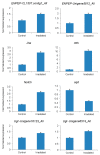Transcriptome Analysis Revealed Genes Related to γ-Irradiation Induced Emergence Failure in Third-Instar Larvae of Bactrocera dorsalis
- PMID: 36354841
- PMCID: PMC9699437
- DOI: 10.3390/insects13111017
Transcriptome Analysis Revealed Genes Related to γ-Irradiation Induced Emergence Failure in Third-Instar Larvae of Bactrocera dorsalis
Abstract
The oriental fruit fly is a polyphagous and highly invasive economically important pest in the world. We proposed the hypothesis that radiation treatment influence RNA expression in the larvae and leads to emergence failure. Therefore, transcriptome analyses of third-instar larvae of B. dorsalis ionizing, irradiated with 60Co-γ at 116Gy, were conducted and compared with the controls; a total of 608 DEGs were identified, including 348 up-regulated genes and 260 down-regulated ones. In addition, 130 SNPs in 125 unigenes were identified. For the DEGs, the most significantly enriched GO item was hemolymph coagulation, and some of the enriched pathways were involved in digestive processes. The subsequent validation experiment confirmed the differential expression of six genes, including sqd, ENPEP, Jhe, mth, Notch, and Ugt. Additionally, the 3401:G->A SNP in the Notch gene was also successfully validated. According to previous research, this was the first comparative transcriptome study to discover the candidate genes involved in insect molt to pupae. These results not only deepen our understanding of the emerging mechanism of B. dorsalis but also provide new insights into the research of biomarkers for quarantine insect treatment with the appropriate dose of radiation.
Keywords: biomarker; invasive; ionizing irradiation; oriental fruit fly; quarantine.
Conflict of interest statement
The authors declare no conflicts of interest.
Figures





Similar articles
-
Transcriptome analysis of the oriental fruit fly (Bactrocera dorsalis).PLoS One. 2011;6(12):e29127. doi: 10.1371/journal.pone.0029127. Epub 2011 Dec 15. PLoS One. 2011. PMID: 22195006 Free PMC article.
-
RNA sequencing to characterize transcriptional changes of sexual maturation and mating in the female oriental fruit fly Bactrocera dorsalis.BMC Genomics. 2016 Mar 5;17:194. doi: 10.1186/s12864-016-2532-6. BMC Genomics. 2016. PMID: 26946038 Free PMC article.
-
Low-Dose Irradiation With Modified Atmosphere Packaging for Mango Against the Oriental Fruit Fly (Diptera: Tephritidae).J Econ Entomol. 2018 Feb 9;111(1):135-140. doi: 10.1093/jee/tox335. J Econ Entomol. 2018. PMID: 29294024
-
Development and Metabolomic Profiles of Bactrocera dorsalis (Diptera: Tephritidae) Larvae Exposed to Phytosanitary Irradiation Dose in Hypoxic Environment Using DI-SPME-GC/MS.Insects. 2024 Mar 6;15(3):177. doi: 10.3390/insects15030177. Insects. 2024. PMID: 38535372 Free PMC article.
-
RNA-seq analysis of gene expression changes during pupariation in Bactrocera dorsalis (Hendel) (Diptera: Tephritidae).BMC Genomics. 2018 Sep 21;19(1):693. doi: 10.1186/s12864-018-5077-z. BMC Genomics. 2018. PMID: 30241467 Free PMC article.
References
-
- Mutamiswa R., Nyamukondiwa C., Chikowore G., Chidawanyika F. Overview of oriental fruit fly, Bactrocera dorsalis (Hendel) (Diptera: Tephritidae) in Africa: From invasion, bio-ecology to sustainable management. Crop Prot. 2021;141:105492. doi: 10.1016/j.cropro.2020.105492. - DOI
-
- Lux S.A., Copeland R.S., White I.M., Manrakhan A., Billah M.K. A new invasive fruit fly species from the Bactrocera dorsalis (Hendel) group detected in East Africa. Int. J. Trop. Insect Sci. 2003;23:355–361. doi: 10.1017/S174275840001242X. - DOI
-
- Leblanc L., Vueti E.T., Drew R.A., Allwood A.J. Host Plant Records for Fruit Flies (Diptera: Tephritidae: Dacini) in the Pacific Islands. Proc. Hawaiian Entomol. Soc. 2012;44:11–53.
-
- Allwood A.J., Chinajariyawong A., Kritsaneepaiboon S., Drew R.A.I., Hamacek E.L., Hancock D.L., Hengsawad C., Jipanin J.C., Jirasurat M., Krong C.K., et al. Host plant records for fruit flies (Diptera: Tephritidae) in Southeast Asia. Raffles Bull. Zool. 1999;47:1–92.
-
- Fletcher B.S. The Biology of Dacine Fruit Flies. Annu. Rev. Entomol. 1987;32:115–144. doi: 10.1146/annurev.en.32.010187.000555. - DOI
Grants and funding
LinkOut - more resources
Full Text Sources

